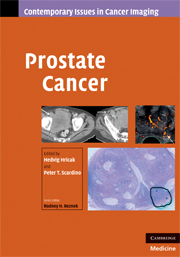Book contents
- Frontmatter
- Contents
- Contributors
- Series Foreword
- Preface
- 1 Anatomy of the prostate gland and surgical pathology of prostate cancer
- 2 The natural and treated history of prostate cancer
- 3 Current clinical issues in prostate cancer that can be addressed by imaging
- 4 Surgical treatment of prostate cancer
- 5 Radiation therapy
- 6 Systemic therapy
- 7 Transrectal ultrasound imaging of the prostate
- 8 Computed tomography imaging in patients with prostate cancer
- 9 Magnetic resonance imaging of prostate cancer
- 10 Magnetic resonance spectroscopic imaging and other emerging magnetic resonance techniques in prostate cancer
- 11 Nuclear medicine: diagnostic evaluation of metastatic disease
- 12 Imaging recurrent prostate cancer
- Index
- Plate section
Preface
Published online by Cambridge University Press: 23 December 2009
- Frontmatter
- Contents
- Contributors
- Series Foreword
- Preface
- 1 Anatomy of the prostate gland and surgical pathology of prostate cancer
- 2 The natural and treated history of prostate cancer
- 3 Current clinical issues in prostate cancer that can be addressed by imaging
- 4 Surgical treatment of prostate cancer
- 5 Radiation therapy
- 6 Systemic therapy
- 7 Transrectal ultrasound imaging of the prostate
- 8 Computed tomography imaging in patients with prostate cancer
- 9 Magnetic resonance imaging of prostate cancer
- 10 Magnetic resonance spectroscopic imaging and other emerging magnetic resonance techniques in prostate cancer
- 11 Nuclear medicine: diagnostic evaluation of metastatic disease
- 12 Imaging recurrent prostate cancer
- Index
- Plate section
Summary
Prostate cancer remains the most common internal malignancy in adult men in the western world. While there are many available treatment regimens for prostate cancer, there are few evidence-based guidelines for treatment selection, and the rationale behind common decision practices prior to localized primary or systemic therapy is continuously evolving. Providing optimal treatment selection and the most accurate outcome prediction requires the consideration and synthesis of multiple patient characteristics, which may include demographics (e.g., age, ethnicity), clinical variables (e.g., laboratory values, imaging features), pathologic findings (e.g., stage and grade), and the molecular characteristics of the tumor (e.g., receptor status, gene expression profiling). The multitude of parameters and diversity of expertise required mean that there has been a paradigm shift in the management of patients with prostate cancer, with a multidisciplinary disease management approach becoming more attractive to patients. For the radiologist, understanding the pathophysiology of prostate cancer, the critical clinical issues, and the advantages and limitations of different treatment approaches is essential for meaningful interpretation of imaging studies, be they ultrasound, computed tomography, magnetic resonance imaging or nuclear medicine studies. Similarly, for the practicing clinician, understanding the advantages and limitations of each imaging modality and appreciating the importance of optimal technique are crucial to rational incorporation of imaging studies into the care of the patient with prostate cancer. Promoting the spirit of a multidisciplinary approach, this volume includes detailed descriptions of anatomy, the natural history of prostate cancer, treatment options and imaging modalities.
- Type
- Chapter
- Information
- Prostate Cancer , pp. xi - xiiPublisher: Cambridge University PressPrint publication year: 2008

